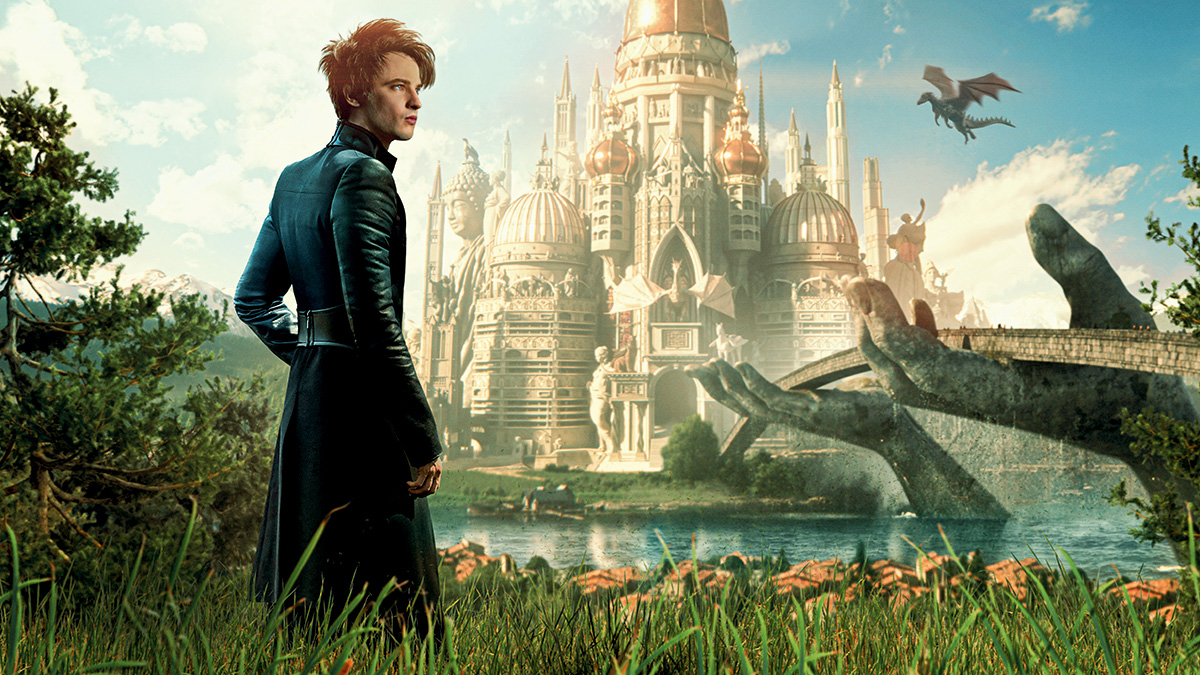How Netflix’s The Sandman Finally Created a Live-Action Version of the Dreaming
The Sandman production designer and visual FX supervisor take us inside the making of the realm of dreams.

This article is presented by: 
Neil Gaiman’s landmark comic series The Sandman is many things: fantastical, idiosyncratic, dark as hell (sometimes literally!), and, honestly, often downright weird. Stuffed to bursting with gods, monsters, real-life historical figures, talking animals, and magic, it’s ultimately a story about the power of stories—why we love them and why we tell them in the first place.
Netflix’s The Sandman arrives this August with a 10-episode first season that fully embraces every dark, larger-than-life aspect of Gaiman’s story on a fantastical journey through worlds both familiar and alien. With lush visuals and beautifully intricate sets, there are moments that feel as though they were explicitly lifted from the pages of the original comic, as well as episodes that deftly blend the stories of multiple issues into something completely new.
“It had to be amazing, no matter what we did,” Jon Gary Steele, production designer for The Sandman, tells Den of Geek. “Everyone felt that energy and that excitement. We were trying to keep it as cool as the graphic novel—stunning, sexy, and beautiful.’”
In the most basic sense, The Sandman follows the story of Morpheus, informally referred to as Dream, the Lord of the Dreaming, and one of seven immortal beings known as the Endless who are each tasked with watching over aspects of reality.
“That’s what everybody’s said before: that it’s unadaptable, isn’t it?” Steele laughs. “It’s epic. And I loved it. It was so interesting to work on something so out there. Every department had to do more and [be] crazier than even we thought it would be. There’s a lot of wild stuff.”
Mirroring the episodic nature of the comic itself, each installment of the Netflix series feels self-contained, seamlessly shifting between time periods, settings, and genres even as it tells a cohesive larger story.
“One of the big challenges on this show is just every episode [is different],” VFX supervisor Ian Markiewicz says. “Each episode has new main players, it has new locations, it has new bit characters, and new additional background. It’s set at a different time [with] a new wardrobe.”
The shifting settings follow Dream and a wide-ranging cast of supporting and ancillary characters through a series of both high fantasy quests and contemporary problems, set in everything from modern-day London to the realm of dreams.
“Episode one is wildly different from everything else. It’s a period piece. And episode two is wildly different from episode one. It’s a fantasy, the first time we’re in the Dreaming,” Markiewicz explains. “And episode three, it’s the first time we’re in contemporary London, and there’s this fantastical demon hunter component. Then we go to Hell, then we’re in John Dee’s diner, and it’s a bottle episode. Each and every time we’re in a different place, a different time, and [only] Dream is the throughline.”
Though the series begins with Dream imprisoned, captured by a mortal occultist, and stripped of the totems of his office (a pouch of sand, a powerful ruby known as the Dreamstone, and the disturbing Helmet of Dreams), the episodes that follow see the newly freed Dream attempt to seek revenge on his captor, rebuild his kingdom, reconnect with his family (who have mixed feelings about his return), and track down his missing symbols of power.
“It’s not a procedural where we’re doing similar things next week. There’s [always] something that’s going to be different about the next episode,” Markiewicz explains. “And Dream may not be onscreen for every frame of the show. [But he] is always going to be at the heart of things.”
Adapting the Unadaptable
Part of the reason previous attempts to adapt The Sandman floundered is the sheer breadth of the story and the lore involved. Though the original story is told in graphic novel form, its roots are in classical literature, mythology, and folklore from a wide variety of cultures. Its scope is almost terrifyingly vast—it touches on life, death, heaven, hell, and everything (quite literally) in between. Trying to adapt its complicated plot for the screen is a truly Herculean task, one that took hundreds of people and nearly a dozen secondary companies to pull off.
“It was definitely daunting,” Markiewicz admits. “One of the things that’s always so challenging—which is also what’s exciting about it—is, ok, we’ve inherited this property, this amazing piece of artwork and literature and fantasy. How can we do it justice? How can we possibly do this thing faithfully while transferring it to the screen?”
This question has haunted every potential adaptation for over 30 years (efforts to adapt The Sandman for the screen have been happening in fits and starts since around 1991).
“Basically, it’s like a train, and you try to make sure each car on the train is part of the whole train,” Steele laughs. “You can kind of see where you’re going, and you know what’s coming—you’ve already designed some of the big pieces like Hell or the Threshold of Desire, which is shaped like the inside of a heart, and all these other things—after that, it just kind of evolved.”
Part of the problem (or challenge, if you’re feeling generous) is that every Sandman fan on the planet has an idea of what Gaiman’s world should look like and their own mental image of who and what the Endless are. And the series’ production team was extremely well aware of that fact going into the project.
“We’re dealing with things that are so subjective now, right? It’s about dreams. It’s about Hell. Everyone has their vision of what that thing should be,” Markiewicz says. “And in some ways, we can never hope to achieve what that is.”
So the team went back to the beginning: Gaiman’s story itself. And not the 1989 comics either, but the author’s original text, which he put together before an artist had drawn a single panel.
“In terms of my prep, one of the things that Allan [Heinberg, showrunner of The Sandman] provided me with, which was gold, was the original comic book scripts from Neil Gaiman,” Markiewicz says. “Not the comic books, not the drawn panels, but the scripts he wrote for the artists [where] he described what he was trying to get at.”
The result is that though there are certain moments in the series which look as though they’ve been lifted directly from the comic panels (because several “absolutely” have), The Sandman series manages to feel like something altogether different.
“I thought that [starting with] Neil’s notes was the perfect way for us to think about adapting the show,” he continues. “Because sometimes the comic book panel is very comic book-y, and it has that wild, quirky, zany quality, which I don’t think the show has all of that much.”
The process of putting The Sandman together was a long one, as well.
“I think we had close to four months’ prep, and we needed all of it,” Steele says. “There’s just so much. You want to build everything. But so much of it was just one step at a time and trying to figure out [what worked and what didn’t], and very quickly, we realized we had to be strategic with our time and resources and money. It was a lot of hard work.”
Dwellers of the Dreaming
One of the things that Sandman fans will likely be excited to see come to life onscreen is Dream’s raven sidekick Matthew. Once a human named Matthew Cable, he transforms and becomes an emissary of the Dreaming after his death. The raven is snarky, brave, and incredibly loyal, sticking by Dream’s side even when he insists he doesn’t need pesky things like help or friends.
“I’m really quite proud of Matthew, and I think the whole visual effects team is proud of Matthew,” Markiewicz says. “It is probably the most successful CG feathered bird that I’ve seen, on film or television, and that’s saying a lot. Because we had a photoreal aspiration for something that was known—the thing was either going to look like a real bird, or it wasn’t.”
In addition to looking like a real bird (albeit one that speaks in Patton Oswalt’s voice), Matthew also needed to be able to move, fly, vocalize, and interact with a variety of human onscreen partners. Furthermore, since Matthew was at one point a human being himself and is one of the few characters that Dream might actually call a friend, his bird form needed to be able to embody a range of almost human expressions and inspire viewers to feel real pathos for him.
The production filmed with multiple trained birds—the “most notorious” of which was known as Mr. T on set—and the use of real animals provided “precious, critical material” for the VFX teams to work with.
“There’s a real joy in seeing Matthew,” Markiewicz says. “You do have to take a step back and realize the whimsy of the show—there are points where you realize, oh, we have a talking pumpkin head talking to a talking bird in this library,” Markiewicz continues. “I hope that people really embrace the journey.”
A Hope in Hell
Though Markiewicz unsurprisingly names Matthew as his favorite character, both he and Steele point to one specific episode as the pinnacle of their achievement in The Sandman’s first season.
“I think that my hope is that the ‘A Hope in Hell’ episode is one that does stand out,” Markiewicz admits. “It’s certainly the one we spent the most time on—trying to figure out how to problem solve it, how to make it happen.”
The Sandman’s fourth episode follows Dream on a journey into the realm of Lucifer Morningstar to retrieve the Helmet of Dreams, which has been stolen and traded away to a demon. His trek into the bowels of Hell itself required the series’ production team to create everything from desolate landscapes strewn with ash, lava, and bone to prison cells built into the side of a mountain and walls comprised of artfully arranged human bodies.
“It was our biggest challenge,” Steele says. “We fought to keep Hell. There were so many conversations about which way to take it. But I have to admit, it was a ton of fun. Tons of sculptors and model makers and construction and paint. Things had to be built: for example, the gate is an actual giant piece of sculpture. It’s amazing.”
“‘I’m really proud of Lucifer’s palace,” Markiewicz adds. “That felt like an impossible nut to crack. I remember the first time that Gary and I were looking at that, and Gary said to me, ‘Do we not show it?’ Because anything that we show of Lucifer’s palace is going to be disappointing—no matter what it is, no matter how cool it is, whatever we show is going to be a little bit underwhelming.”
In the end, according to Markiewicz, Lucifer’s fantastical realm was largely based on real-life images.
“There’s a lot about Lucifer as Lightbringer that we specifically tried to design based on Western Catholicism,” he explains. “I specifically modeled that piazza on the Vatican. [Visuals] tend to always feel more grounded and more real if we can start with something that is real. The look back on Lucifer’s palace from the demon’s view looking up—that’s one of the cathedrals in Milan. We loved the strong, striking, imposing component: the foundations, the Gothic spires. We felt like Lucifer would totally use the same iconography.”
Markiewicz mentions multiple other inspirations for the look and feel of Lucifer’s kingdom, including Auguste Rodin’s famous Gates of Hell sculpture, the art of Hieronymus Bosch (“The Garden of Earthly Delights”), and the poetry of John Milton (“Paradise Lost”). In a way, this melding of different styles of art and iconography is wildly fitting for an adaptation of Gaiman’s work, which is built on the fusion of so many genres, cultures, and tales.
“It was a really fun challenge to make sure that we always had all these references available. Not just of Sandman, but also all this surrounding mythology. You can’t help but be humbled by its level of sophistication—finding the root name of the word that is the character that refers back to the fable that it’s then based on. There’s always a story. That was why the graphic novel was so interesting to begin with.”
The Sandman is streaming now on Netflix.
